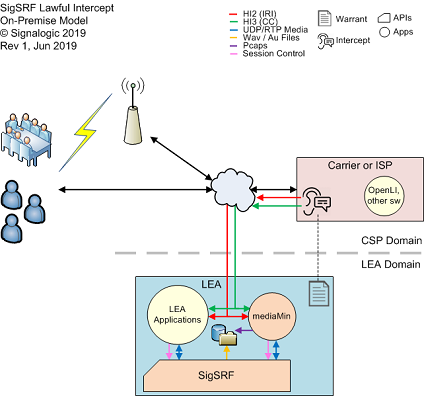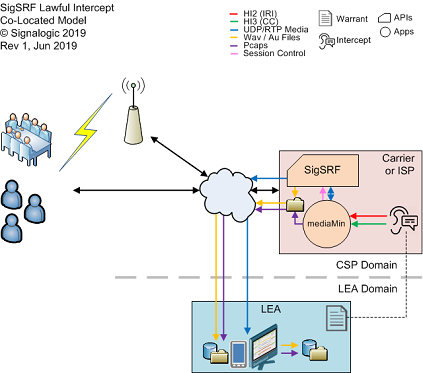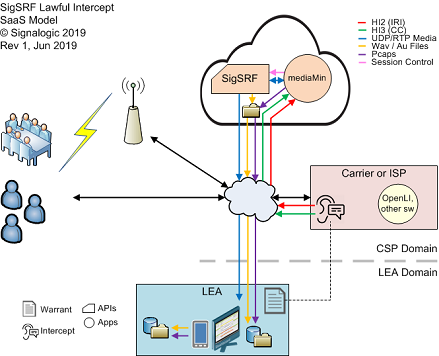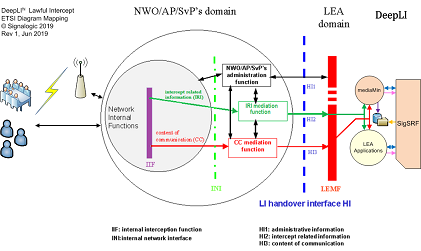
|
|
DeepLI™ Lawful Interception software maps to the LEA domain in ETSI HI (Handover Interface) functional block diagram (ETSI TS 133 108 v14.0.0 ◳ Figure 4.1) |
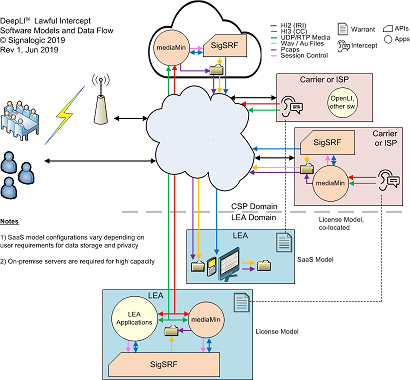
|
|
DeepLI™ Lawful Interception software supports flexible site models, including On-Premise, Co-Located, and SaaS (cloud LI). See Site Models below |
DeepLI™ - Lawful Interception Software
- Overview
- Product Info
- Product Description -- Lawful Interception Features
- Site Models
- Telecom Mode
- Analytics Mode
- Audio Quality
- Stream Alignment
- High Capacity
- Test Regimen
- Application and Diagnostic Table
- API Interface
- Packet Logging
- mediaMin and mediaTest Demos
- OpenLI 4 support ◳
- Published Source Code
- Related Applications
- How To Get a Quote
- Related Items
- Tech Support
Overview
DeepLI™ (Deep Lawful Interception) is a new generation of Lawful Interception software with emphasis on site model flexibility, extreme high capacity, superior audio quality, and deep learning. Site models include on-premise, co-located, and SaaS (cloud LI). Addition of deep learning support is ongoing, including speech recognition and diarization. DeepLI is currently deployed in Tier 1 LEAs and carriers 1. Here are key reasons why:- Extreme high capacity and reliability on standard Linux servers. For on-premise implementations, maximum session capacity exceeds 500 concurrent sessions on standard servers 2
- Highest audio quality -- innovative algorithms for inter-stream alignment, stream gap concealment, packet loss mitigation, audio frame loss concealment, and RTP stream merging (multiple endpoint merging)
- Robust -- continuous stress testing applied in Signalogic labs, with a minimum of 600 hrs prior to a new release
- Ready-to-use -- full featured reference applications for basic applications, and minimum API interface callable from C/C++ for high capacity, application-specific use cases
- Ultra secure -- developed and tested entirely in the US, in labs based in north Texas and the Bay Area, with no outsourcing. Zero dependencies on open source except for codecs and Linux. No third-party libraries. Protected source codes are not stored on AWS, Azure or any other untrustworthy outside data center. Cyber and security reviews of source code can be arranged 3
- Test regimen -- due to many customer relationships over many years, Signalogic maintains a database of 100s of RTP media pcaps, covering an enormous range of test cases, including all types of codecs, multiple streams, child streams (RFC8108), with/without packet arrival times, early media, call-waiting gaps, DTMF, etc
- Telecom Mode or Analytics Mode operation
- Complete packet flow including pcap or UDP I/O, packet and multiple SSRC handling (RFC8108), jitter buffer, transcoding, voice algorithms, variable ptime, and numerous RFCs
- Signal processing including real-time RTP stream merging, stream deduplication, insertion of user-defined signal processing, FLC (frame loss concealment), AGC, echo cancellation, and more
- Extreme concurrent session capacity on x86 Linux servers
- OpenLI 4 support ◳
2 For example, each session with two (2) EVS wideband streams and one (1) AMR-NB stream on an HP DL380 running Ubuntu Linux
3 Depending on business case discussions conducted under NDA
4 OpenLI ◳ is an open source project maintained by the University of Waikato ◳
Product Info



|
| Signalogic Part P/Ns | DSSIG-DEEPLI-VOLTE, DSSIG-DEEPLI-STREAM, DSSIG-DEEPLI_ASR |
| System Manufacturer |
Signalogic |
| Description | DeepLI Lawful Interception Software |
| Product Categories | HPC (High Performance Computing), Media Resource Functions, Algorithms |
| Product Status | Deployed |
Default tab content (this text) shown when (i) no tabs are automatically selected, or (ii) if rel value for the tab ="#default".
Stock: 0
On Order: 0
Delivery: Electronic (secure download)
Qty 1: Request Quote
MOQ: 1
Current Promotions: None
Product Description - DeepLI Features
|
Site Models |
On-Premise, Co-Located, SaaS (cloud LI) |
|
Operating Modes |
Telecom, Analytics. Both modes support packet send rates slower or faster than packet ptime, and Analytics mode includes an option for pcaps without arrival timestamps |
|
Applications |
mediaMin: ready-to-use LEA application, with output options including UDP/RTP, wav file, and pcap |
|
APIs |
Two levels of API are available: (i) fine-grained control at the packet/media thread level, and (ii) simplified, minimal interface based on session setup and packet queue push/pull. The mediaMin application is based on the minimal API. Section 3.1, Minimum API Applications, in SigSRF documentation ◳ contains a source code example showing a packet push/pull loop implemented in 10 lines of C code |
|
I/O |
I/O includes UDP/RTP, pcap, and waveform file. IPv4 and IPv6 supported. wav, .au, compressed bitstream, and other file formats supported |
|
Capacity |
50 sessions per core 1 |
|
Stream Processing |
Stream group setup and management, real-time RTP stream merging and deduplication, user-defined signal processing. RTP stream merging output options include real-time UDP packet flow, unified mono wav file and pcap, and per stream pcap and either mono or N-channel wav file. Stream deduplication removes reverb when the same source appears on multiple streams |
|
Session Management |
Static and dynamic session creation from (i) session configuration files, (ii) SDP info, (iii) IRI info, or some combination. Dynamic session creation includes an RTP audo-detect option. Live session control and modification |
|
Codecs |
EVS, AMR-NB, AMR-WB, AMR-WB+, G711, G729, G726 |
|
Jitter Buffer |
Advanced options include dynamic re-ordering depth, packet loss mitigation, burst/gap compensation, SID and media packet repair, dynamic stream creation (RFC8108), on-demand flush, RFC7198 (temporal), live stats. Inter-stream packet rate mismatch and fluctuation compensated up to 20% |
|
Multithreading |
Multistream, multisession, multichannel, fully re-entrant, XDAIS compliant. See also "Capacity" in this table |
|
DTX, SID, CNG |
DTX can be applied and controlled on per session basis, or automated depending on codec type. VAD available for older codecs without inherent DTX support |
|
PLC and FLC 2 |
Includes (i) codec decoder output and (ii) stream merging audio output |
|
Voice/Packet Handling |
DTMF, echo cancellation, sampling rate conversion, variable ptime, tone generation, and other audio and RTP processing |
|
Stress and Functional Test |
Documentation includes dozens of functional and stress test command lines and reference pcaps, along with test validation information |
|
Logging |
Event and packet logging. Packet logging includes SSRC group collation, analysis of dropped, missing, and duplicated packets, and timestamp matching |
|
Energy Saver |
Packet/media thread inactivity detection and throttle down, with user-specified settings |
2 Packet Loss Concealment and Frame Loss Concealment
Site Models
Site models supported by DeepLI include On-Premise, Co-Located, and SaaS (cloud LI). The diagrams below show platform architecture and data flow for these models.- SaaS models are flexible, depending on data privacy, session capacity, and other application-specific requirements
- High capacity figures quoted here and in SigSRF documentation ◳ require private servers, typically deployed in an On-Premise model
Telecom Mode
DeepLI™ telecom mode supports direct handling of bidirectional IP/UDP/RTP traffic. This mode is sometimes also referred to as "clocked" mode, as a wall clock reference is required for correct jitter buffer operation. Examples of telecom mode applications include network midpoints such as SBC (Session Border Controller) and media gateway, and endpoints such as handsets and softphones. Typically telecom applications have hard requirements for real-time performance and latency. A telecom mode data flow diagram is shown below.
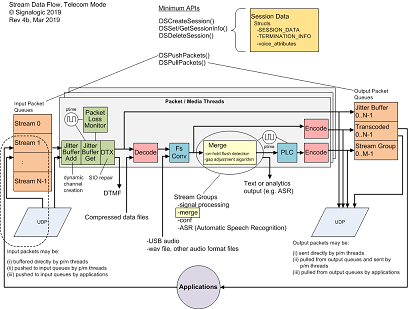
|
| DeepLI™ Lawful Interception telecom mode flow diagram |
Analytics Mode
DeepLI™ analytics mode supports indirect handling of IP/UDP/RTP traffic, where traffic is encapsulated or "one step removed", having been captured, copied, or relayed from direct traffic for additional processing. This mode is sometimes also referred to as data driven or "clockless" mode, the latter description referring to jitter buffer packet processing either wholly or partially without a wall clock reference. In general, analytics mode applications operate after real-time traffic has already occurred, and process uni-directional traffic, although depending on the application it may be necessary to reproduce or emulate original real-time behavior and handle output endpoints. In addition to Lawful Interception, examples of analytics mode applications include web IT data analytics such as speaker identification and automatic speech recognition (ASR). An analytics mode data flow diagram is shown below.
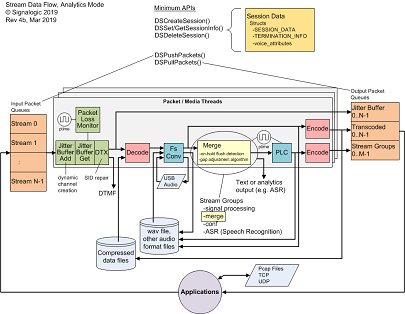
|
| DeepLI™ Lawful Interception analytics mode flow diagram |
Audio Quality
DeepLI™ places utmost emphasis on audio quality. A number of areas in the software contain packet, media, and signal processing algorithms designed to achieve the highest possible audio quality. These include:- media and SID packet repair. Packet loss gaps up to 5 ptimes for media and 3 ptimes for SID are repaired. Techniques include PLC and backward/forward looking estimation based on surrounding context
- dynamic jitter buffer, including late packet holdoff, resync, and burst flushing
- interstream gap handling, including pastdue data for stream group processing (e.g. stream merging)
- stream group output frame loss concealment (FLC)
- optional stream deduplication algorithm, to remove reverb between similar streams

|
| Wireshark capture showing 1 sec timing markers added to stream group output |

|
| Wireshark capture showing output buffer boundary timing markers added to stream group output |
Audio Quality Testing
Audio quality testing is part subjective and part quantitative. Subjective testing takes a lot of time and several human listeners to agree that yes, quality is acceptable. In the extreme case, a panel of listeners is convened over several days and a Mean Opinion Score (MOS) is determined. This complexity makes quantitative testing methods desirable, although difficult. DeepLI incorporates the following quantitative audio quality test methods:- injecting visual markers in media output; the above displays show two examples
- end-of-call run-time stats summary and event logging. Run-time stats summaries can be use to keep functional test case records, for later comparison to see if any stats have changed due to application or system modifiecations, or comparisons between systems
- per stream and stream group wav output, for subsequent examination by media analysis tools such as Audacity, Matlab, Hypersignal (see examples below), etc
- alarms and event logging for packet cutoff and thread preemption, to aid forensic analysis of audio quality disruption events such as network outages, Linux system issues, etc

|
| DeepLI end-of-call run-time stats summary example, showing dynamic session creation of 3 EVS streams and one AMR-WB stream, child stream creation (RFC8108), and stream group output |
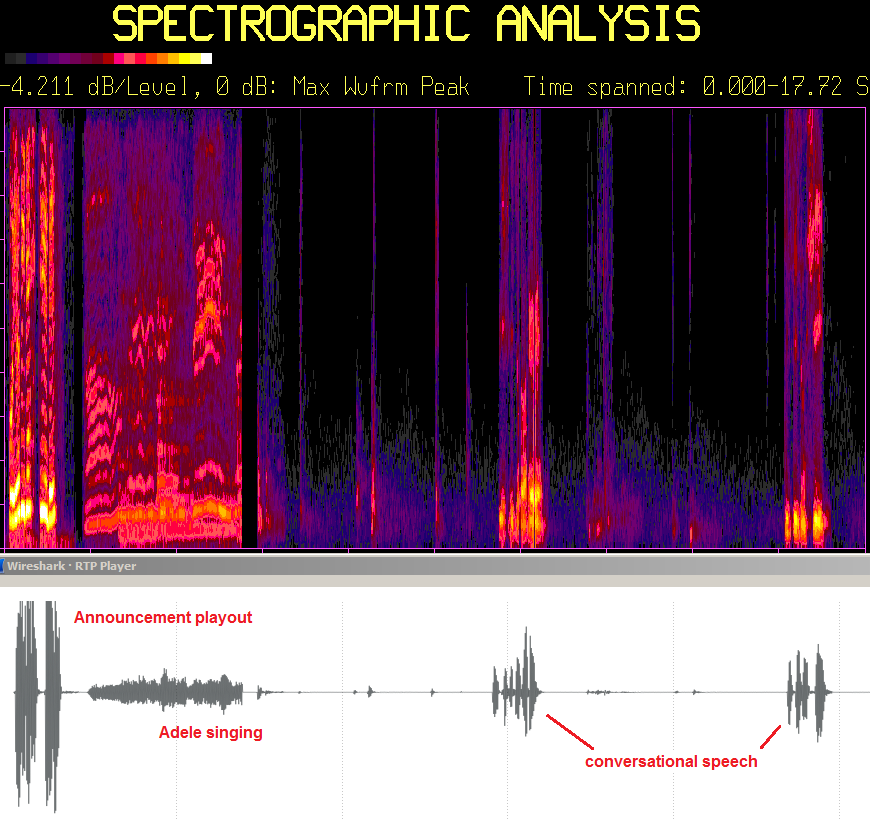
|
| Frequency domain sliding FFT spectrographic analysis of stream group wav output (using Hypersignal heatmap option) |
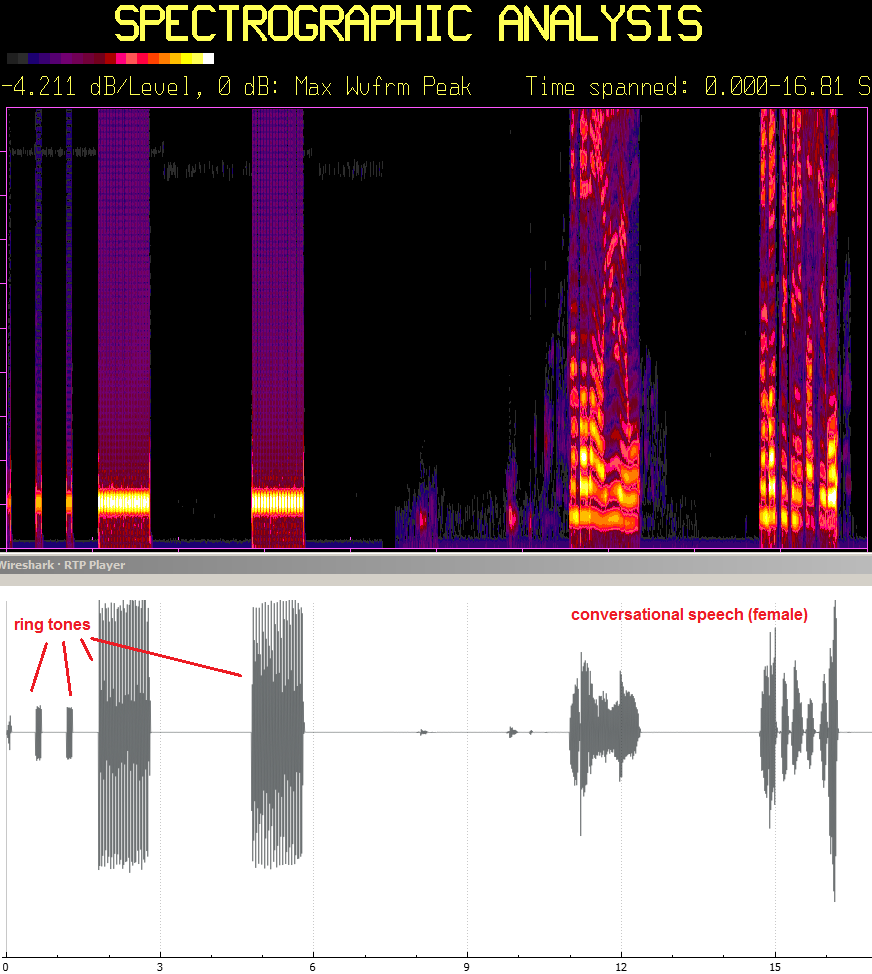
|
| Frequency domain sliding FFT spectrographic analysis of stream group wav output (using Hypersignal heatmap option). This example includes early media ring tones |
Stream Alignment
Applications that merge RTP streams from multiple endpoints, such as conversational ASR and diarization, remote work groups, and lawful interception, often require extremely accurate stream alignment. Merged output must assemble in real-time, maintaining exactly regular sampling intervals. Endpoints with different latencies, packet send rates, and other variations make this task challenging. DeepLI™ handles this with a series of algorithms developed in US based labs due to multiple customer engagements in telecom, analytics, and embedded system applications. Below is an overlay of Wireshark screen caps showing an example of multiple streams merged into a combined, real-time audio output.
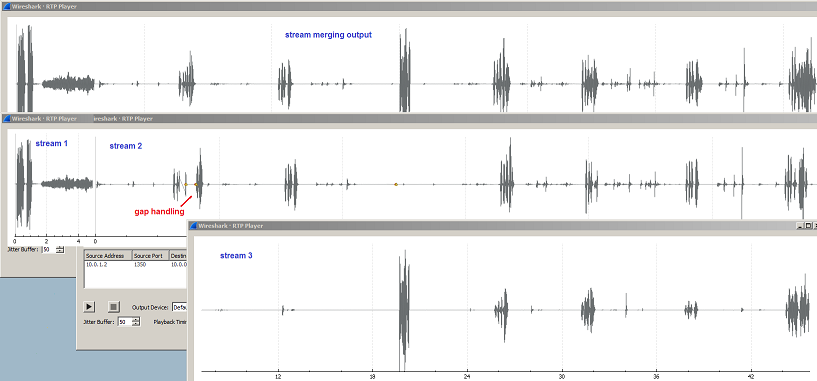
|
| DeepLI™ example of multiple stream alignment and real-time merging |
High Capacity
DeepLI™ was architected from inception for high capacity, multicore, concurrent thread operation. Below is an htop screen capture showing 504 concurrent sessions running on a 32-core Xeon server.
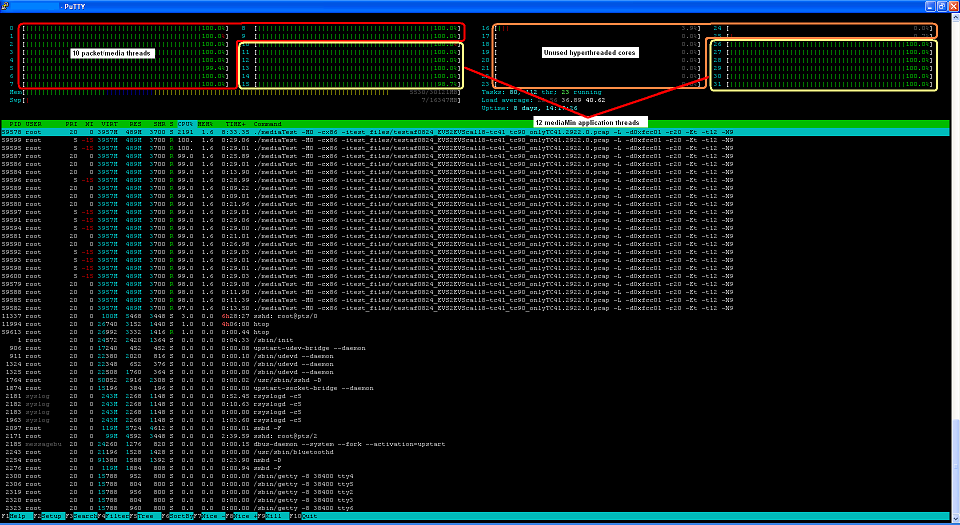
|
| DeepLI™ htop display showing high capacity packet/media processing, 504 concurrent sessions |
Test Regimen
Functional Tests
Due to many customer relationships over many years, Signalogic maintains a database of 100s of RTP media pcaps, covering an enormous range of test cases, including:- all types of codecs
- packet loss -- intermittent and sustained up to 10%
- sustained high and low send rates
- multiple streams
- multiple child streams, both SSRC creation and resume (RFC8108)
- with/without packet arrival times
- early media
- call on-hold and call waiting gaps
- sequence number and timestamp wraps
- DTMF RTP events
- long duration (multiple hours)
Stress Tests
Signalogic continuously runs stress tests on separate servers dedicated to 24/7 testing. These include repeating, random combinations of functional tests, high capacity tests, "extreme conditions" such as 1 msec packet push rates, packet gaps, removals, and other impairments, artificial Linux thread stalls, and others.Capacity Tests
The SigSRF documentation includes a number of mediaTest and mediaMin command lines for capacity tests, including multiple application threads, multiple packet/media threads, and combinations. See the High Capacity section, above.Application and Diagnostic Table
DeepLI™ application and diagnostic functionality is shown in the table below. General functional areas are shown at left, then further subdivided. Diagnostic functionality includes test and measurement capabilities provided by the mediaTest application. As noted above, both mediaMin and mediaTest are reference applications based on SigSRF shared library modules (SigSRF Github page ◳ ).|
Functionality |
Application |
Diagnostic |
|
|
I/O |
UDP/RTP, IPv4 and/or IPv6 |
mM |
mM, mT |
|
pcap |
mM |
mM, mT |
|
|
Waveform files, .wav, .au, .tim formats |
mM |
mM, mT |
|
|
USB audio |
|
mT |
|
|
Compressed bitstream data files, .cod format (header full and compact header payload format modes supported), .bit, .amr and .awb formats |
|
mT |
|
|
Intercept |
Web interface providing intercept organization and configuration, control of mediaMin instances, and session creation definitions and stream group assignments |
|
|
|
Session Creation |
Static creation from session configuration files |
mM |
mM, mT |
|
Dynamic creation from SDP info, stream RTP auto-detect |
mM |
mM |
|
|
Dynamic creation from IRI info |
mM |
mM |
|
|
Stream |
Per stream processing, see "Packet Processing and Transcoding" table entry below. Stream group setup and management, RTP stream merging, stream deduplication, and user-defined signal processing. Merging includes real-time audio and UDP output, and pcap and wav file output (both mono and N-channel wav file). Stream deduplication removes reverb when the same source appears on multiple streams |
mM |
mM |
|
Stream burst/gap compensation and rate misalignment correction |
mM |
mM |
|
|
Packet Processing and Transcoding |
Jitter buffer re-ordering depth, DTX, SID, CNG, packet loss mitigation, SID and media packet repair, dynamic stream creation (RFC8108), on-demand flush, RFC7198 (temporal), run-time stats |
mM |
mM, mT |
|
Transcoding |
mM |
mM, mT |
|
|
Variable ptime (transrating) |
mM |
mM, mT |
|
|
DTMF event handling, tone detection and generation |
mM |
mM, mT |
|
|
Sampling rate conversion |
mM |
mM, mT |
|
|
AI and Deep Learning |
Speech recognition, language detection, speaker identification, and diarization |
mM |
mM, mT |
|
Test,
Validation, Benchmarking, Interactive Debug |
Stress test, single app thread,
multiple packet/media threads, multiple sessions. Event log validation |
|
mM, mT |
|
Stress test, multiple app threads,
multiple packet/media threads, multiple sessions. Event log validation |
|
mT |
|
|
Functional test and validation of
audio quality and packet log |
|
mM, mT |
|
|
Low level API test, debug, and
custom configuration for SigSRF shared library modules, including pktlib, voplib, streamlib, inferlib, alglib, diaglib, and hwlib |
|
mT |
|
|
Performance benchmarking for
encoder + decoder, encoder-only, and decoder-only. Command line entry for encoder
bitrate, channel aware, DTX (VAD) |
|
mT |
|
|
Interactive commands, including
debug output, pause/resume, stats, and profiling. Stats include thread, session, stream
group, channel, and energy saver.
Profiling includes CPU usage for packet/media thread, stream group,
and codec processing |
|
mT |
|
|
Packet tracing |
|
mT |
|
|
PLC |
Codec |
mM |
mM, mT |
|
FLC |
Stream group |
mM |
mM |
|
Logging |
Event |
mM |
|
|
Packet |
mM |
|
|
|
Application Specific Customization |
Customization of API usage, diagnostics, logging, debug output, and stats output |
mM |
mM, MT |
|
Energy Saver |
Packet/media thread inactivity detection and throttle down |
mM |
mM |
Legend
|
mM = mediaMin |
|
mT = mediaTest |
|
Application Level |
|
Partial demo available |
|
Under development |
Notes
- CC = Communication Content (aka ipMMCC)
- CNG = Comfort Noise Generation
- DTX = Discontinuouis Transmission
- FLC = Frame Loss Concealment
- IRI = Interception Related Information (aka ipMMIRI)
- PLC = Packet Loss Concealment
- SDP = Session Description Protocol
- SID = Silence Insertion Descriptor
- VAD = Voice Activity Detection
API Interface
DeepLI™ provides two levels of API:- Fine-grained control at the packet/media thread level
- Simplified, minimal interface based on session setup and packet queue push/pull
/*** Packet push / pull loop excerpt from mediaMin source ***/
do {
if (fPause) continue; /* skip push/pull loop if pause is in
effect */
if (Mode & USE_PACKET_ARRIVAL_TIMES) PushPackets(pkt_in_buf, hSessions, session_data, thread_info[thread_index].nSessionsCreated, thread_index); /* in this mode, PushPackets() will push a
packet for each session only if elapsed time exceeds the packet's arrival time
*/
/* packet input interval elapsed
? In Analytics mode (FTRT mode, -r0 cmd line entry) frameInterval is zero, so we push packets as fast as possible. For cmd line entry -rN we push packets at N msec intervals */
gettimeofday(&tv, NULL); cur_time = tv.tv_sec * 1000000L + tv.tv_usec; if (!base_time) base_time = cur_time;
if (cur_time - base_time < interval_count*frameInterval[0]*1000) continue; interval_count++; /* if interval has elapsed, push and pull packets, increment interval. Comparison is in usec */
/* read packets from input pcap files, push to packet/media thread */
if (!(Mode & USE_PACKET_ARRIVAL_TIMES)) PushPackets(pkt_in_buf, hSessions, session_data, thread_info[thread_index].nSessionsCreated, thread_index);
#ifdef SINGLE_STEP
if (isMasterThread) { printf("After
push\n"); fPause = 1; continue; }
#endif
/* pull available packets from
packet/media thread, write to pcap files */
PullPackets(pkt_out_buf, hSessions, DS_PULLPACKETS_JITTER_BUFFER, sizeof(pkt_out_buf), thread_index);
PullPackets(pkt_out_buf, hSessions, DS_PULLPACKETS_TRANSCODED, sizeof(pkt_out_buf), thread_index);
PullPackets(pkt_out_buf, hSessions, DS_PULLPACKETS_STREAM_GROUP, sizeof(pkt_out_buf), thread_index);
/* check for end of input, end of packets send by packet/media thread (to which the session is assigned), flush sessions if needed */
FlushCheck(hSessions, cur_time, &queue_check_time, thread_index);
/* update screen counters */
UpdateCounters(thread_index);
/* update stress test conditions, if
enabled. Note that repeating tests
exit the push/pull loop here, after each thread detects end of input and
flushes sessions */
if (!StressTestActions(hSessions, uFlags_session, thread_index)) break;
} while (!ProcessKeys(hSessions, thread_index)); /* process interactive keyboard commands, continue until 'q' key is entered */
Note that packet output queues are separated into jitter buffer, transcoded, and stream group. For more information on the above source code excerpt, and packet push/pull queues, see SigSRF documentation ◳ section 3.1, Minimum API Applications.
Packet Logging
Upon application request, DeepLI generates a detailed packet log, including input packet history, jitter buffer output packet history, input packet statistics, and comparison / analysis of input vs. output. Below is an example packet log, edited for brevity.
Ingress Packet info for SSRC = 0x6506e546, first seq num = 8, last seq num = 13023 ...
Seq num 8 timestamp = 11200, pkt len = 6 SID
Seq num 9 timestamp = 13120, pkt len = 33
Seq num 10 timestamp = 13440, pkt len = 33
Seq num 11 timestamp = 13760, pkt len = 33
Seq num 12 timestamp = 14080, pkt len = 33
Seq num 13 timestamp = 14400, pkt len = 33
Seq num 14 timestamp = 14720, pkt len = 33
Seq num 15 timestamp = 15040, pkt len = 33
:
:
Seq num 85 timestamp = 176000, pkt len = 33
Seq num 86 timestamp = 176320, pkt len = 33
Seq num 88 ooo 87 timestamp = 176960, pkt len = 33
Seq num 87 ooo 88 timestamp = 176640, pkt len = 33
Seq num 89 timestamp = 177280, pkt len = 33
Seq num 90 timestamp = 177600, pkt len = 33
:
:
:
[ additional input streams ]
Jitter Buffer Packet info for SSRC = 0x6506e546, first seq num = 8, last seq num = 51340 ...
Seq num 8 timestamp = 11200, pkt len = 6 SID
Seq num 9 timestamp = 11520, pkt len = 6 SID CNG-R
Seq num 10 timestamp = 11840, pkt len = 6 SID CNG-R
Seq num 11 timestamp = 12160, pkt len = 6 SID CNG-R
Seq num 12 timestamp = 12480, pkt len = 6 SID CNG-R
Seq num 13 timestamp = 12800, pkt len = 6 SID CNG-R
Seq num 14 timestamp = 13120, pkt len = 33
Seq num 15 timestamp = 13440, pkt len = 33
:
:
:
[ additional output streams ]
** Packet Stats and Analysis **
Stream groups found = 1, group indexes = 0
Stream group 0, 3 streams
Stream 0, channel 0, SSRC = 0x13883145, 156 input pkts, 156 output pkts
Input packets = 156, ooo packets = 0, SID packets = 0, seq numbers = 0..155, missing seq numbers = 0, max consec missing seq numbers = 0
Input packet loss = 0.000%
Input ooo = 0.000%, max ooo = 0
Output packets = 156, ooo packets = 0, seq numbers = 0..155, missing seq numbers = 0, max consec missing seq numbers = 0, SID packets = 0, SID R packets = 0, repaired SID packets = 0, repaired media packets = 0
Output packet loss = 0.000%
Output ooo = 0.000%, max ooo = 0
Packets dropped by jitter buffer = 0
Packets duplicated by jitter buffer = 0
Timestamp mismatches = 0
Stream 1, channel 2, SSRC = 0x6506e546, 12912 input pkts, 51333 output pkts
Input packets = 12912, ooo packets = 1346, SID packets = 5652, seq numbers = 8..13023, missing seq numbers = 104, max consec missing seq numbers = 1
Input packet loss = 0.805%
Input ooo = 5.212%, max ooo = 2
Output packets = 51333, ooo packets = 0, seq numbers = 8..51340, missing seq numbers = 0, max consec missing seq numbers = 0, SID packets = 5702, SID R packets = 38320, repaired SID packets = 53, repaired media packets = 51
Output packet loss = 0.000%
Output ooo = 0.000%, max ooo = 0
Packets dropped by jitter buffer = 0
Packets duplicated by jitter buffer = 0
Timestamp mismatches = 0
Stream 2, channel 4, SSRC = 0xb6ef05cc, 50862 input pkts, 51325 output pkts
Input packets = 50862, ooo packets = 8876, SID packets = 0, seq numbers = 65..51389, missing seq numbers = 463, max consec missing seq numbers = 2
Input packet loss = 0.910%
Input ooo = 8.726%, max ooo = 2
Output packets = 51325, ooo packets = 0, seq numbers = 65..51389, missing seq numbers = 0, max consec missing seq numbers = 0, SID packets = 0, SID R packets = 0, repaired SID packets = 0, repaired media packets = 463
Output packet loss = 0.000%
Output ooo = 0.000%, max ooo = 0
Packets dropped by jitter buffer = 0
Packets duplicated by jitter buffer = 0
Timestamp mismatches = 0
Note in the above packet log example, out-of-order input packets are marked as "ooo".
mediaMin and mediaTest Demos
The SigSRF SDK download page (Github) ◳ contains free, limited demo versions of the mediaMin and mediaTest reference applications, including source code, along with several mediaMin and mediaTest command line examples ◳. In addition to Lawful Interception functionality and OpenLI support ◳, the demos provide test, measurement, diagnostic, and event / packet logging examples. Demo limitations include number of concurrent sessions, number of packets processed, and functionality. To remove or relax functionality limits, customized trial versions are available upon request and subsequent to business case discussion. All C/C++ source code for both applications is published.Published Source Code
Published C/C++ source code includes:- SigSRF header files
- all source and Makefiles for the mediaMin and mediaTest applications1
- packet/media thread source demonstrating full use of the SigSRF API
- signal processing source for stream group output
- stream deduplication
- insertion of user-defined signal processing
Related Applications
Other available software related to DeepLI:How to Get a Quote
Enter the fields shown above, including:- CPU Type
- License Type
- Product Configuration
Related Items
| 1) Codec Wav Samples, before and after encode/decode ◳ |
| 2) mediaMin and mediaTest demo download (Github page) ◳ |
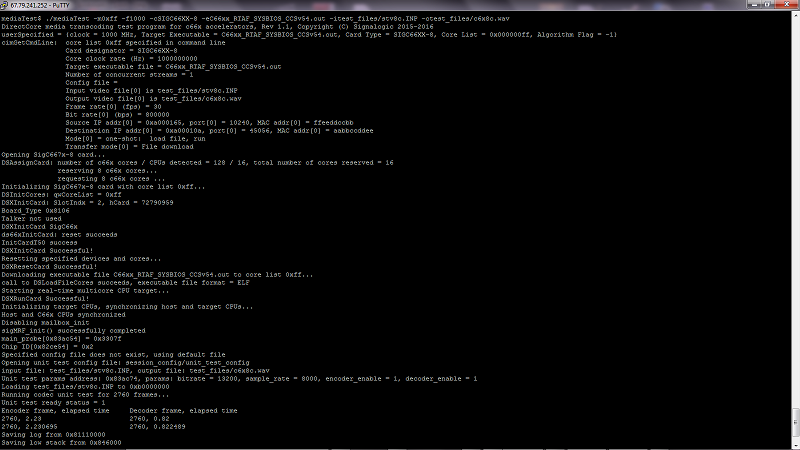
|
| mediaTest high capacity media session transcoding screen capture, showing EVS codec performance benchmarking in diagnostic mode |
| 3) Surveillance Video Suspect Detection and Tracking ◳ |
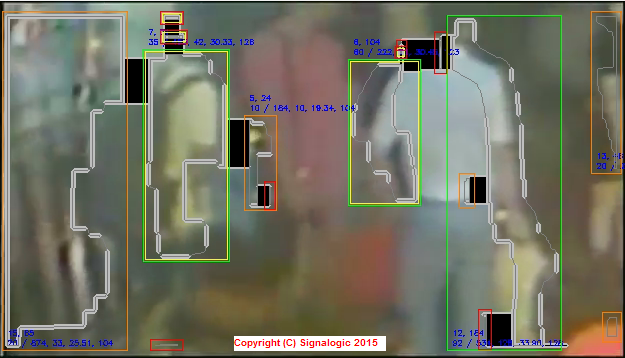
|
| Vidilant suspect detection software screen capture of surveillance video analysis |
| 4) ffmpeg Acceleration ◳ |
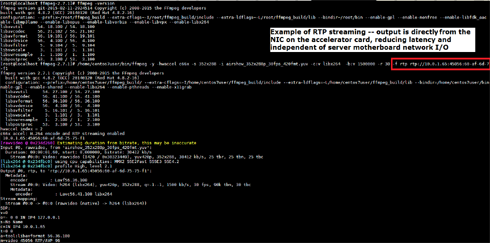
|
| FFmpeg screen capture with c66x acceleration enabled |




